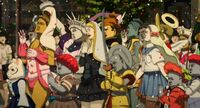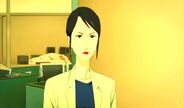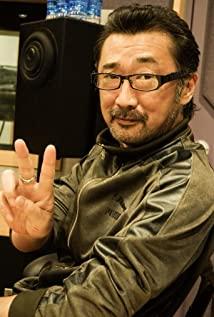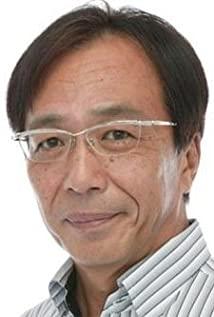Director Jin Min is my favorite animation director. His animation films are not only ups and downs in plot, but also have profound ideological significance; they are also a model of experimental innovation in the audiovisual language of the lens. Here, I will analyze the audiovisual language of "Red Pepper", and I won't say much about the plot ideas. His powerful lens capabilities are indeed admired.
The first paragraph of "Red Pepper" is also one that I personally think is very outstanding in terms of audiovisual language. Police officer Fanchuan and Red Pepper shuttle through different scenes with different images. The tight rhythm and tension-filled camera movement left a deep impression on the audience.
The Red Pepper and Fenchuan police officers switched from the performance stage to the primeval forest. The director used a flash camera to immediately turn from the first scene into a flying streamline, quickly reaching the primeval forest scene. The use of such a lens expresses the inner connection of different spaces, and also connects different scenes coherently with its strong visual effects.
The connection between the kidnapping scene and the movie shooting scene is also vivid. The director will be the action of smashing people across two different scenes and complete an action together between different scenes to connect. Played a role in echoing each other.
The moment the red pepper hits someone with a guitar, the picture freezes, and suddenly someone runs away. The motion in the stillness becomes more prominent. The camera turns into the audience's eyes to follow him, and police officer Fenchuan also chases after him.
In the scene from the Fanchuan police officer chasing him to the corridor, the director used a "jumping" connection. "Going out" is immediately followed by "Entering the door", omitting unnecessary processes in the middle, and arranging the scenes closely and smoothly.
The fast switching of this short shot will definitely bring a strong visual impact to the audience. In the middle of the movie, there is a bridge section between the red pepper and Fenchuan in the elevator. Every time the elevator stops one floor, it will reach a scene in the opening section.
At the beginning of the film, when the director, Tokada, and Chiba were about to enter the director's room together, the director swiped his card to enter the scene. Lens 1: Panoramic view, the director takes out the card, Lens 2: Close-up of the director's hand, swiping the card. In order to make the picture smooth and avoid visual jumps, the director grasped the action editing point-the turning point of the action in the transition of the shot. To subdivide the action of the scene, swiping the card is the action itself, then the card swiping is the preparatory action. Often the action editing point is after the preparatory action and before the formal action. This not only makes the connection smooth, but also simplifies the intermediate process. The director also has another purpose here, that is, in the close-up shot of the director's swiping hand, the three words "director's room" clearly written on the door explain the location.
Chiba opened the curtains in the ice room laboratory and saw a scene behind a ladder. Chiba climbed down the ladder. The director looked down at the camera and watched Chiba's movements from the audience's point of view. The next scene is Chiba jumping from a ladder to the ground. Here again, the camera editing point is used to switch the action. Climbing down the ladder is a preparatory action to jump to the ground. The two shots are connected smoothly and coherently. This shot of Chiba jumping to the ground turned the objective shot into a more subjective shot, turning from the audience's viewpoint to that of Chiba. The next action is to "lead" Chiba to explore the scene below the ladder.
At this time, a butterfly appeared in the picture, and the butterfly flew outside the door. The director let the butterfly fly into the camera for a certain purpose. This is about the fulcrum of scene scheduling. Here, the butterfly is a fulcrum. It not only guides the sight of the audience, but also guides the sight of the character Chiba, becoming a scene in Chiba's subjective sight. It is this butterfly that becomes the starting point for Chiba's next movement toward the door, and becomes the support for the connection between the shots.
Chiba walked to the door where the butterfly flew step by step, wanting to find out. The shots range from panorama, close-up to close-up. Such shots are connected to form a progressive narrative montage. There is also a camera director who used it very beautifully: Chiba took a close-up shot of a follow-up camera that walked outside the door, and then took a moving aerial shot. A sports lens is used here to express the empty scene, one is to form a dynamic connection with Chiba’s walking, and the other is to show that Chiba is walking, and her sight approaches the door step by step. The empty scene here is Her subjective sight.
After the close-up shot of walking in Chiba, I used a fade-out and fade-in connection to connect to another scene. This kind of connection allows the audience's vision to get a short break, and also makes the transition between different scenes natural and not rigid. The fading scene is the Ferris wheel, the audience can see at a glance, the Ferris wheel is the scene outside the door of Chiba.
The red pepper brought police officer Fenchuan to watch a movie. Constable Fenchuan refused: "I hate watching movies." When Constable Fenchuan finished saying this, the director used three parallel, but different directions, consecutive and rapid closing shots. To enhance the atmosphere. The scene of closing the door and the sound of the door hitting the floor aggravated Fenchuan's tone, showing the determination of the Fenchuan police officer. The background changes from bright to dark, and it also shows a solemn atmosphere.
Police officer Fanchuan drove, recalling what the director said just now, "I really miss my school days." The camera changed from the car in Fanchuan to the middle shot of Fanchuan in the car, and then to the close-up, close-up, and large close-up shots. Pudovkin's progressive "montage" narrative composition. The connection of each scene is not a blunt switch, but a continuous dissolve, which makes the lens transition natural and simplifies the conversion process. The reason why the director uses dissolve here is because of its virtual and real visual effect, which is very suitable for expressing memories and recollections, so that the vision can be extended to express thinking. It also implies that the Fanchuan police officer needs to accept because of certain memories. Psychotherapy.
Then the director used a series of shaking shots to express Fan Chuan's illusion. This kind of shaky and unstable shots showed Fan Chuan's restlessness and played a very good role in psychological expression.
The director and Chiba reached an agreement that it was time to send red peppers out to rectify the dream, and the camera transition from Chiba's transformation to red peppers was full of tension. The director uses a neutral lens here. Chiba is facing the camera, filling the screen, and then the red pepper goes from full screen to off-camera. The connection between the two characters shows the inner connection between the two, that is, the two of the same character. Clones. This kind of lens connection and the rapid change of viewing distance also enhance the impact of the screen.
When the red pepper was in danger and called the director to wake Chiba, he also used this extremely fast full-screen shot to transition. From the red pepper's face gradually full to the screen to Chiba's face and then quickly away from the camera, the rapid change of scenery and the rapid music created a tense atmosphere.
After Koyamachi subdued the red pepper, he wanted to make the red pepper into a specimen. When he boasted that he had successfully completed the miniature DC, the director gave Koyamachi a looking up camera, which impressed me. The lens is the middle shot of the hill, and the wide-angle lens is used with the elevation angle, so the perspective contrast between the near big and the small is stronger, and it is used to express the brag of the "powerful" image in the hill. At the same time, the lying red pepper looks at the angle of view inside the hill.
There are many shots, pictures, and language that appear repeatedly in the movie. For example, Fanchuan's line "What should I do with the rest?" repeated many times in the film. Later, Fanchuan confided to the bartender in the bar why he hated movies and was afraid of 17. This back-and-forth echoing in the film, revealing the causes and consequences of each other makes the film more attractive and persuasive.
Fanchuan held the sleeping Chiba, when he was about to escape. The director used a neutral reverse shot. With just two lenses, I can see the entire scene of Fanchuan from front to back. I changed the scene and followed the director’s sentence "Escape to your own dream." The scene smoothly switched to the virgin forest, and at the same time changed the direction of the screen. It reduces the intermediate actions, shortens the time and space, and also expresses the connection between the two scenes.
So the plot echoes the rapid switching of a series of short shots at the beginning. But here, it explains why Fanchuan will make that series of measures.
After Fanchuan shot the hill inside, the movie had another dramatic scene. The director instantly turned the background into an old movie style, and then pulled the screen into the theater that filled the audience. Show the heroes of Fanchuan to save the beauty. Forming the picture in the form of a movie also expresses his realization of his desire to make a movie and his understanding of that long-lost nightmare. A lens is full of multiple meanings. Because the plot layout is so wonderful, a plot analysis was inserted when analyzing the audio-visual language.
The whole film is remarkable in terms of plot, structure, audiovisual language, film meaning, and music. As far as audiovisual language is concerned, what I analyze is only a part of the shots, and there are many scenes that are unforgettable. In short, no matter what, "Red Pepper" is worth recommending.
View more about Paprika reviews











